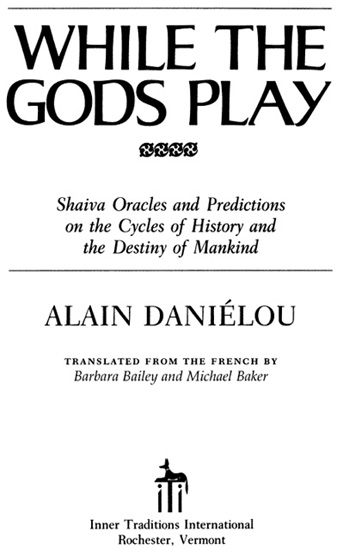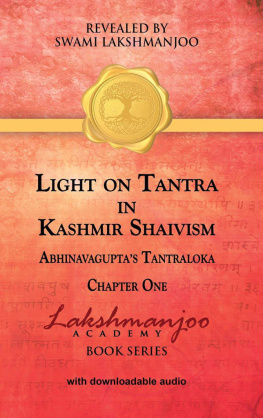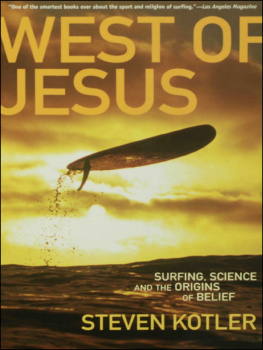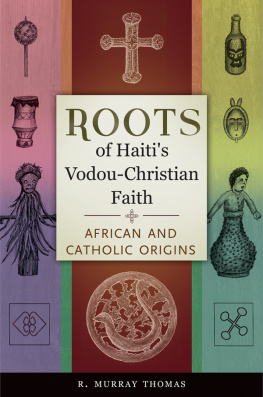
Note on the Transliteration of Sanskrit Terms
AS EXACT A PRONUNCIATION AS POSSIBLE IS AS MUCH essential for the ritual formulae and the magical sense of words as for establishing the parallels between different languages. The Sanskrit alphabet is a syllabic alphabet consisting of fifty-two phonetic signs. The syllables can be long () or short (a). The consonants are voiceless or aspirated (t or th). Certain vowels of the old phonetic system have disappeared from the pronunciation of modern Sanskrit. Such is the case with (as in the English word above), these days pronounced "ri," which is transcribed either as e or ri , and with (which does not occur in English, but is closest to the French u as in vu), pronounced "lri" and transcribed either as or lri . An a occurring at the end of a word is not pronounced in Sanskrit. It corresponds to the final silent e in English. It is denoted by . Yog should be pronounced "Yog", Shiv as "Shiv." Shiv is feminine, a name of the goddess.
The retroflex consonants are shown underscored: t , th , d , dh , sh ,n . The palatal nasal is written , the guttural nasal .
.
The English sound oo (as in book) is represented by the letter u. The modern Tamil alphabet is based on the same phonetic system. Sanskrit words are written with a capital letter in the text, and the plural is neither shown by an s nor otherwise indicated. I have added an (s) for clarity.
In the translation of Sanskrit and Tamil texts I sometimes incorporated some explanatory words added by the scholars who quote them or taken from commentaries. Later I added some quotes from modern works that I noted in the course of my research.
In the exposition of the doctrines of Shaivism, I have followed the terminology of the Sanskrit versions of the Smkhy(s) and the gam(s). At times I have added Dravidian terms to the Sanskrit words or to their translation.

Introduction
WE ARE SO ACCUSTOMED TO REGARDING THE EVOLUtion of humanity as a constant progression, and the development of knowledge over the course of several centuries or even several decades as a continuous forward movement, that we sometimes have difficulty in realizing that contrary forces also exist which periodically return peoples to states of incredible barbarism.
Important civilizations pass away, their highly developed scientific knowledge suddenly annihilated. In such cases, the only lingering echo is the vague remembrance of a Golden Age, or sometimes a few monuments remain which reveal a knowledge so evolved that our ancestors of only a few generations ago were not only incapable of deciphering it but even of having any idea of what sort of knowledge they were witnessing.
We use the rather vague term tradition to evoke the fragments, which have come down to us through secret and esoteric channels, of this ancient and prestigious knowledge, whose substance we have lost even though we have preserved its memory. There are periods in the course of history in which we encounter attempts to recover something of this ancient knowledge. The emperor Hadrian gathered together a great number of scholars to try to recapture the science of the ancient Egyptians. Later on, in Italy, a group of artists, scholars, and philosophers formed the Accademia Vitruviana, then the Accademia Romana, providing the beginning impulse of what is called the Renaissance in Europe. This group had also sought to recover elements of the knowledge of the Egyptians, the Etruscans, and the Pelasgeans. Its members were tortured and massacred by the Borgia popes, and the survivors dispersed, leaving only a few enigmatic writings.
In India, around the time of Christ, there was an astonishing personality called Lakulish who dared to stand in opposition to official Vedism and Buddhism, and enabled the ancient Shaiva religion to be reborn. With it the sciences and religious and philosophic concepts that had been "underground" for nearly two millennia came to the fore and provoked a prodigious effervescence in the domain of culture and the arts. Its representatives were likewise gradually eliminated, and modern Hinduism retains only a degraded remnant of it. The true knowledge is once again enclosed in esotericism.
Some texts dating from the pre-Aryan civilization of India were partially recuperated during the period of the Shaiva revival. I have attempted, often with difficulty, to study and understand the conceptions they present of ancient Shaivism concerning the nature of the world and the destiny of man, and to present certain aspects of these conceptions in this book. Obviously I can give here only a brief summary. The upholders of the tradition, always under threat, are reticent and secretive. Their knowledge is often fragmentary, and the level of the concepts sometimes goes quite beyond the scientific and philosophic notions with which I am familiar, posing arduous problems of comprehension and terminology. There remains, however, a vast corpus of texts, for the most part unpublished, which represent a body of knowledge coming from the depths of the ages. These texts deserve to be studied by people more qualified than I. I have limited myself to the texts that I thought understandable concerning cosmology, the nature of language, and musical semantics. I was not competent to approach the texts on mathematics, astronomy, or medicine, and hope that others will be able to explore them. What is important in such research is, first of all, to be conscious of the limits of our own knowledge and neither to reject nor to seek to bring to our level notions that seem bizarre or incomprehensible at first approach. The situation is analogous to that of a man of the eighteenth century being able, by a phenomenon of vision, to read certain texts of modern physics.
Vanity on the part of ethnologists and Orientalists often leads them to aberrant interpretations and absurd judgments.
My work will be useful if it succeeds in awakening the curiosity of even a few scientists at the forefront of research, several of whom have indicated to me their astonishment at the discovery, clearly expressed in this ancient knowledge, of concepts that they themselves hardly dare to envisage, such as the structural identity of the cells which form the galaxies and the cells which form our bodies, or the necessity of the omnipresence of consciousness as one of the essential components of interstellar and atomic matter, the relativity of time, and the purely energetic nature of matter, all of which are concepts familiar to the Smkhy.

PART ONE
THE HUMAN ADVENTURE

Origins
ACCORDING TO THE CHRONOLOGY OF THE PUR N , THE present humanity would have appeared about 58,000 years ago, a figure that corresponds to twelve and a half times what Shaiva cosmology calls the Age of the Ancestors (Pit ri ), that is, the duration of a lineage, a particular species of men. But men or similar beings existed before the present humanity. The human species that have succeeded each other on earth have each achieved a very high level of development and knowledge, then disappeared at the time of planetary catastrophes, leaving, however, traces that served as the bases for the development and knowledge of subsequent humanities, which, when they reach the limits of the knowledge permitted man in the plan of creation, are, in their turn, destined to disappear.
Next page








 .
.